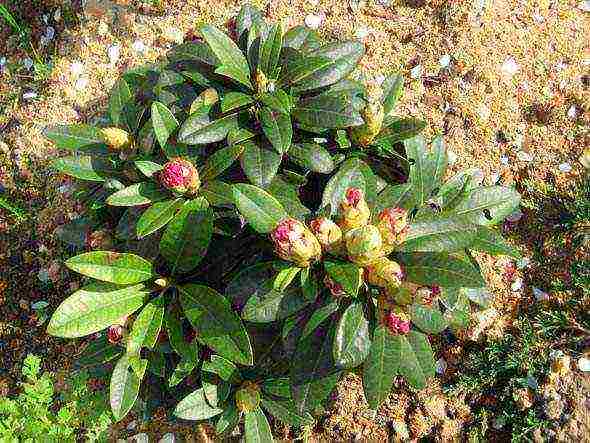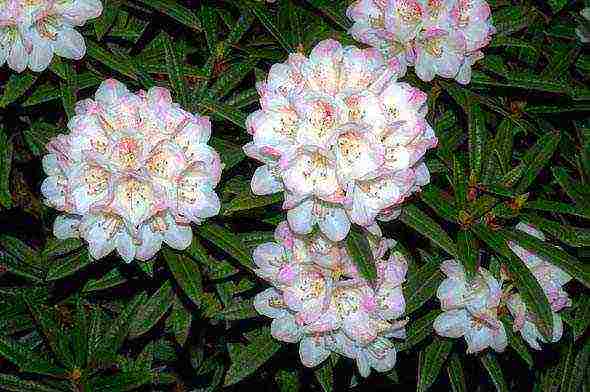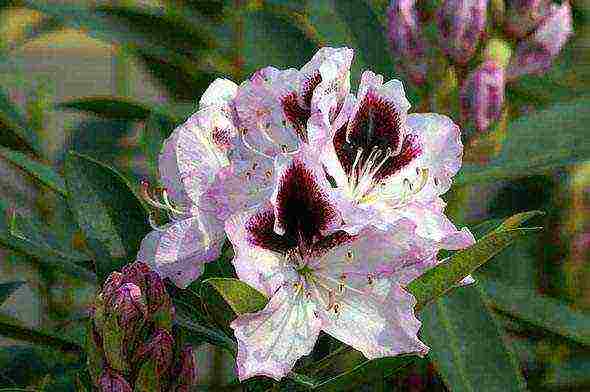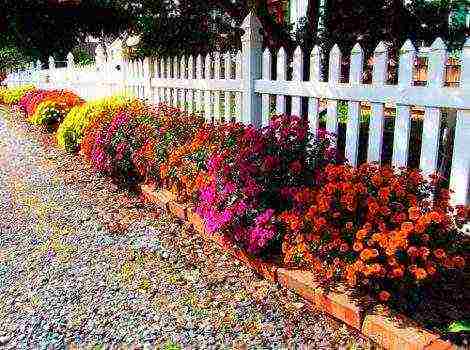Content
05.24.2014 updated | 05/30/2011 |
Even 15-20 years ago, only specialists and selfless amateur gardeners knew about rhododendrons. Now the last Belarusian summer resident considers it bad form not to have at least one copy of a luxurious shrub on his site.
However, the capriciousness of the "king of the garden" often negates the efforts of the owners of six acres, who want to decorate their possessions with it. How to avoid failure if you intend to "settle" rhododendron in your garden? Recommendations from the portal
www.interfax.by
.
Setting the stage: king on the needle
Not every land is "to taste" for rhododendron. Only acidic soil will suit the "royalty". The ideal level is pH 4.5 - 5.5. If your site does not meet this request, you will have to "hunt" for red peat and go to the forest for needles. An option for lazy and wealthy gardeners is to buy a ready-made soil mixture for rhododendrons or azaleas.
Prefer pine butcher than spruce: it will quickly create the necessary microclimate in the soil. Filling a large plastic bag with fallen needles, proceed from the following calculation: for one shrub - ½ the contents of the container.
Acting with a rake, discard excessive caution: together with coniferous litter, it is advisable to bring the top layer of wild soil from the forest. If last year's foliage falls under your tool of work, feel free to send it to the bag too.
Choosing a royal corner
Direct sunlight is harmful to delicate and capricious rhododendrons. Therefore, open areas, generously illuminated by the daylight in the midday heat, reject without regret.
But the light partial shade will be very much to the liking of the rhododendron. It can be provided by a net stretched on pegs or foliage of an "over-aged" tree. The main thing is not to make the neighborhood of a tree and a shrub too close and not to miss the side of the world: the southern one is not good.
Also, for some varieties of rhododendrons (mainly evergreen), you need to consider protection from the wind. For example, in winter, for this purpose, you can build a protective "mini-hut" of 3-4 stakes and throw a spunbond over them.
Dig a hole for another
The "dimensions" of the rhododendron pit are standard. So, regardless of whether you are planting an annual or three-year plant, the diameter of the "depression" should be about 70 cm, the depth - up to 50 cm (the roots of rhododendrons do not grow deeper).
Waving a shovel heartily, do not rush to fill the hole with a prepared or store-bought “nutrient mixture”. It is important to make sure that the rhododendron will not suffer from excess moisture in the soil. To do this, fill the hole halfway with water, and after 1.5-2 hours check if it has gone into the ground. If not, you will have to resort to drainage procedures.
Ceremony with landing
To plant the "king of the garden", it is advisable to wait for a cool day. If the sun is warming with might and main, and there is no way to delay the "resettlement", organize it in the evening before.
After the planting ceremony, water the "new settler" abundantly, but do not overdo it: it is important that the roots of the plant do not "choke". Alternatively, before planting, immerse the root ball in water until no more air bubbles. And then place it in a hole dug according to its size and, sprinkling it with soil, compact it around the perimeter of the coma. Mulch with coniferous litter (5-7 cm).In this situation, in the first week, you usually do not need to worry about watering the rhododendron. All that is required of you during this period is to carefully observe the condition of the leaves.
We cherish and cherish the royal person
The main directions of caring for the "king of the garden" are watering, mulching and feeding.
For the "thirst quenching" of rhododendron, rain, river and pond water is best suited. On hot days, do not be lazy to spray the leaves, if you do not want to arrange a "last hero" test for a delicate plant.
Mulching should not be neglected, because it provides an optimal level of soil moisture, and in winter protects the roots of the "sissy" from frost. Mulch twice a year: in early spring and late autumn.
As for feeding, after planting the shrub, it will not be needed for a long enough time, provided that you have prepared a high-quality soil mixture. Subsequently, you will need to use fertilizers that acidify the soil. Keep in mind that the "shock dose" of fertilizers often leads to the death of the rhododendron, so do not get carried away with them.
Fungal diseases affect rhododendrons quite rarely, but leaf-gnawing pests have to be fought from time to time. Insecticides guarantee success in the fight against them.
Andrey Zubarev, Researcher
State Scientific Institution "Central Botanical Garden of the National Academy of Sciences of Belarus"
In the photo - rhododendrons
Of the Central Botanical Garden of the National Academy of Sciences of Belarus.
It was under this name that at the end of May, in the Central Botanical Garden of the National Academy of Sciences, a holiday dedicated to a rare in beauty and flowering duration (April - July, depending on the variety) shrub - rhododendron, whose name in Greek means "rose tree" (rhodon - rose, dendron - tree). Sounds!
The genus of rhododendrons is large and varied - more than 1,300 species. It includes evergreen, semi-evergreen and deciduous shrubs and trees. But the rhododendron from the heather family has nothing to do with the rose from the Rosaceae family. They are related only by beauty and variety of species and varieties.
In Belarus, the first collection plantings of rhododendrons appeared at the end of the 19th century in the botanical garden of the agricultural school in Gorki. But, alas, they have not survived. And in the Central Botanical Garden, the beginning of the collection was laid in the mid-60s of the last century by the famous specialist-introducer, candidate of agricultural sciences Ivan Efimovich Botyanovskiy. He brought 10 species of seedlings from the Tallinn Botanical Garden and planted them in the nursery. Thanks to his efforts and diligence, more than 90 species of rhododendron from different countries have been tested.
After that the collection of rhododendrons was supported by A. Zlotnikov and V. Grinkevich. And since 2005, it has been supervised by the deputy director for science of the Central Botanical Garden of the National Academy of Sciences, candidate of biological sciences Ivan Volodko.
- Today in our arboretum there are 34 species, 9 forms and 28 varieties of rhododendrons, - says Ivan Kazimirovich, - whose homeland is Eastern China, Korea, Japan, North America, Siberia, the Far East, Europe, etc. included in the State Register of Botanical Collections.
The secret of the popularity of rhododendrons is quite understandable. First, some of them are evergreen. Agree, their dark green leathery leaves look very exotic on the snow. Secondly, today it has become fashionable to have these plants in your garden. And most importantly, their bloom is an amazing sight.
But before you decide to have pink trees, you need to understand their nature.
King on the needle
When choosing a landing site, keep in mind that it must be protected from prevailing winds and direct sunlight. Most of the wild-growing rhododendrons in nature hide under the canopy of trees. Therefore, the areas adjacent to the northern walls of the buildings are what you need. It will also be good for bushes under pines and not very dense spruces.
In open sunny areas, some species (in particular, short-fruited rhododendron) feel uncomfortable: the leaves turn brown at the edges, stunted and lose their decorative effect. An important factor is the acidity of the soil. The ideal pH level is 4.5 - 5.5. Otherwise, you will have to look for red peat and needles. Pine butcher is preferable to spruce: it quickly creates the necessary microclimate in the soil.
The planting hole should be 40-50 cm deep (the roots do not go further) and up to 90 cm in diameter. Fill it with high-moor peat or a mixture of forest litter from under coniferous trees, rotted manure and coarse sand. You can also buy ready-made soil mixture for azaleas and rhododendrons.
When planting, it is important to make sure that the water does not stagnate and the plant does not suffer from waterlogging. To do this, fill the finished hole halfway with water, and after a couple of hours check if it is gone. If not, you will have to think about drainage. It can be a 15 - 20 cm layer of broken brick, gravel, rubble or sand.
Many guidelines instruct you not to bury the root system. When using high-moor peat, according to our scientists, this condition can be ignored. After planting, make a raised-edged near-stem hole around the bush and water liberally.
The distance between plants depends on the height and diameter of the crown of the bush and averages from 0.7 to 2 m.
Since rhododendrons have a shallow root system and it develops mainly in the humus horizon, the plantings must be mulched with coniferous sawdust, bark or chips. This will not only allow maintaining a favorable water regime, but also partially relieve weed from weeding. And in winter it will protect the roots from frost.
As for feeding, immediately after planting it is not needed: if the soil is prepared correctly, then the plant already has enough nutrition. In the following years, it is possible in the spring to apply mineral fertilizers containing nitrogen, phosphorus and potassium in the ratio of 2: 1: 1.5 to the trunks of the trunks - "Ammonium sulfate", "Superphosphate", "Potassium sulfate" at the rate of 30 - 40 g per 1 sq. ... m.
After flowering, feed the bushes with a mixture of 2 parts phosphorus and 1 part potash. This will improve budding for the next year. You can also use the Kemira-potato complex fertilizer: 50 - 70 g per plant. The first feeding is carried out in the spring, while the plant has not yet started to grow, the second - after flowering.
So that they were sour
In dry times, water the rhododendrons abundantly, adding a bucket of water under each plant 2 to 3 times a week. It is good to spray the bushes, but not in the heat. Better in the early morning or late afternoon, so as not to burn the leaves.
The surest sign of moisture deficiency is that the leaves become dull and droop, brown spots appear along their edges, similar to a picture of fungal diseases. Ideally, the water for irrigating rhododendrons should be soft (rain or snow) and acidic. By the way, other heathers, both decorative and fruit, do not tolerate hard water: heathers, ericas, blueberries, garden cranberries and lingonberries, etc.
On alkaline soils, rhododendrons begin to ache and become deficient in nitrogen. The first sign is yellowed leaves. Then they dry up and the plant dies. To soften, the water is acidified with oxalic, citric, acetic or other organic acid - at the rate of 3-4 g per bucket of water.
Some growers use electrolyte for acid batteries: 10 - 20 ml per bucket of water reduce the pH from 7 to 4 - 5 units. The electrolyte is the same sulfuric acid, only diluted. And therefore there is no risk of burning the plants. This time. Secondly, in this way we not only acidify the soil, but also add sulfur - a vital element for heathers.
With proper care, rhododendrons bloom in the 4th - 6th year, sometimes even earlier.The first flowering is most often weak, and the flowers that appear are best cut off immediately so that the plant can maintain its strength for more abundant and prolonged flowering in subsequent years. Leave just a couple to see the color of the petals. Do not leave faded inflorescences. By removing them, you will not allow the seeds to form, and accordingly the plant will use up all the nutrients for laying flower buds for more lush flowering next year, as well as for the growth of shoots. If you remove the inflorescences from the "young", it will accelerate the formation of new branches and help the shrub to grow faster in width and height.
Winter with comfort
In order for rhododendrons to successfully overwinter, they must be properly prepared for frost. The most important thing is to water abundantly in the fall, until the soil is frozen.
It is better to cover evergreen rhododendrons in the first 2 - 3 years after planting with spruce branches, and undersized species - with a completely dry oak leaf, craft paper or tar paper, which is stretched over the frame.
In deciduous rhododendrons, branches can be bent to the ground so that they are covered with snow in winter. In late March - early April, the shelter is removed. But on evergreens, part of it is left to protect the plants from spring sunburn.
It must be said that late spring and early autumn frosts do not pose a great threat to rhododendrons. Most varieties during the active vegetation and flowering period are able to withstand 3 - 5 – degree frosts. True, at the same time, with spring frosts, the growth of the current year may suffer. Generative flower buds are usually damaged in winter after prolonged thaws. The most susceptible to them are rhododendrons of European and Far Eastern origin. It is they who, if the autumn is warm, bloom again in September, October and even November.
Exact copy
Rhododendrons can be propagated both by seeds and vegetatively.
Seeds are sown at the end of winter in boxes or pots on the surface of the soil, watered with soft and acidic water, covered with glass or film to maintain high humidity. High-moor peat can be used as a substrate. Before filling in pots, it will be useful to pickle the mixture with a strong solution of potassium permanganate.
At room temperature, seedlings will appear in 2 - 3 weeks, and in some species even earlier. When the first leaves appear, transfer the seedlings to a cooler room, where the temperature is about plus 8 - 12 degrees.
The seedlings of rhododendrons are small and tender, it is best to water them through a sump, filling it with water until the soil is completely saturated. Drain the rest of the water. When the first true leaves appear on the seedlings, they can be cut into pots or containers with a volume of 0.1 - 0.2 liters. By autumn, the seedlings can be taken out into the open ground, where they can winter.
A cassette method of growing seedlings has been tested in the Central Botanical Garden of the National Academy of Sciences. Scientists have also developed methods for obtaining rhododendrons with open and closed root systems. According to their technology, from 100 sq. m of protected ground, you can get up to 10.000 seedlings, which in the 2nd - 3rd year reach the standard size.
Varietal rhododendrons are propagated exclusively by vegetative methods. In particular, semi-lignified cuttings. They are cut in the second half of June with a length of 5 - 8 cm, making an oblique cut at the bottom. Rooted in a substrate of peat and sand (1: 1), sawdust and sand (3: 1) or a mixture of peat, perlite and sand (2: 2: 1).
Remove the lower leaves, and leave the upper 2 - 3 completely. Treat the cuttings with any growth stimulant. "Kornevin", for example. Place them in the substrate at an angle of 30 degrees. Press down, water, and cover the drawer with glass or plastic. Cuttings root better at a substrate temperature plus 24 - 26 degrees. The air temperature should be 2 degrees lower. A prerequisite is high moisture content of the soil and the surrounding air cuttings.
Deciduous rhododendrons take root after 1.5 months, evergreens - after 3 - 4.5 months. The rooting results depend on the species and variety.
“The most promising is clonal reproduction,” says Ivan Kazimirovich. - It allows you to get a lot of healthy planting material in a short time with a minimum amount of starting material. This method was developed in the Central Botanical Garden in the Department of Plant Biochemistry and Biotechnology.
Nice company
When creating landscape groups, do not plant deciduous and evergreen rhododendrons together. And, if possible, pick them up in height: in the center - the highest, at the edges - the lowest.
Rhododendrons look very decorative next to conifers: spruces, pines, thujas, yews. Bushes with bright flowers are especially impressive against a solid dark background.
You can plant rhododendrons in various containers. Best suited for this are the compact Yakushima rhododendron, as well as the Japanese evergreen species.
by the way
Cut flowers of rhododendron retain their freshness for a long time. One inflorescence, more than 20 cm in diameter and consisting of 10 - 18 flowers, is quite capable of replacing a bouquet.
Have you noticed a mistake? Please select it and press Ctrl + Enter
Did you like the material? Rate it.
Rhododendron is a highly decorative shrub that belongs to the Heather family. There are many varieties and varieties of this plant. In nature, rhododendron can be found in the form of a shrub and tree. Rhododendron: Planting and care requires special attention from the gardener.
Description of species and varieties
The height of a rhododendron depends on its species and variety. So cultures with high decorativeness are distinguished by the shape of the leaf. There are 26 types, which are divided into three groups.
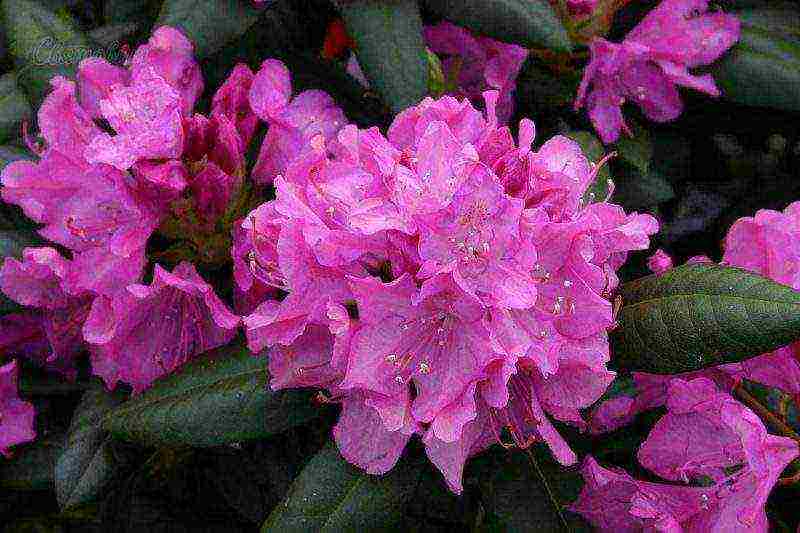
Table 1 - Groups and types of rhododendrons
| Evergreen | These are shrubs that do not shed their leaves even in winter. The foliage is dark green in color. Flowers - large, have a variety of colors. They grow mainly on well-drained, peat-rich soil. | Daurian rhododendron is an evergreen bush that reaches a height of 2-4 m. The leaves are glossy, small in size. The flowers are large, the diameter does not exceed 4 cm, mainly purple in color. Flowering continues for a month. It propagates well by cuttings. |
| Rhododendron Adams is a winter-hardy, evergreen bush with a spreading crown. Leaves are green, ovoid. Flowers are small, in one inflorescence no more than 15 pcs. | ||
| Caucasian rhododendron is a low, evergreen shrub. The leaves are dark green, oblong. | ||
| Deciduous | It is a shrub that sheds its foliage before the onset of winter. During the flowering period, the bush is completely decorated with flowers. | Canadian rhododendron is a shrub with dense branches, up to 1 m in diameter. It blooms in the first half of May, flowers up to 3 cm in diameter are bright lilac, sometimes white. In one year it grows by 15 cm. |
| Kamchatka rhododendron is a dwarf shrub no more than 0.3 m high. It begins to bloom in the first half of June, the flowers are large and have a crimson color. It is able to withstand temperatures down to -27 degrees. Prefers moist, well-lit areas. | ||
| Rhododendron yellow is a deciduous shrub, reaches a height of 2 m. It has small bright yellow flowers. The leaves are elongated, green in color. The yellow azalea blooms in early May. | ||
| Hybrid | These are varieties of rhododendrons bred by breeders when crossing different species. | "Azurvolke" is a hybrid, evergreen rhododendron. In height reaching up to 1 m. The diameter of the crown is 1.5 m. The flowers are blue, sometimes purple. The leaves are oblong, up to 3 cm long and 1 cm wide, have a dark green color. |
| "Berry Rose" is a hybrid, deciduous shrub, reaching a height of 1.5-2 m. Green leaves up to 5 cm long, up to 3 cm wide. It blooms in the second half of May and blooms until the third decade of July. Flowers - pink, up to 8 cm in diameter. | ||
| "Blue Tit" is a hybrid, evergreen shrub, up to 1 m in height. It has a rounded crown, up to 1.5 m in diameter. The leaves are rounded, bluish-green in color. Blooms in the first half of May. The flowers are lavender-blue, 3.5 cm in diameter. The variety is resistant to low temperatures. |
The nuances of growing a plant
The site for planting a rhododendron should be on a hill so that water does not stagnate at the roots. Azalea does not tolerate drafts and burning sunlight. On the north side, the plant must be protected from cold gusts of wind, and in the spring from the scorching sun. Therefore, a good place to plant is the northeastern or northern side of the fence, building.

Conifers will be the best neighbors for the rhododendron. Plants with surface type roots: willow, maple, linden will be unsuccessful.
Shrubs will not grow in alkaline or normal soil. It should be acidic with a large layer of humus, no lime, and good oxygen permeability.
Landing in open ground
Rhododendrons: Outdoor planting and care require special attention from the gardener. So before planting, you need to prepare the material for growing. The best soil for a flower is a mixture of peat and clay in equal proportions.
Rhododendron planting procedure:
- a hole is dug up to a depth of 0.4 m and a width of up to 0.6 m;
- a drainage layer of sand and pebbles with a height of 0.15 m is laid on the bottom;
- then fall asleep with a mixture of peat (most) and loam;
- the soil is tamped and a hole is made for an earthen clod of a rhododendron seedling;
- the roots of the seedling are lowered into the hole and covered with soil. The root collar should be flush with the ground;
- after planting, the bush is watered abundantly with non-cold water;
- from above they mulch with straw, moss, rotted needles.
To make the plant better accepted, a few minutes before planting, the seedling is soaked in a bucket of water. And keep in it until air bubbles disappear from the surface of the water.
How to care for a rhododendron
The rhododendron flower requires regular watering, weed removal, seasonal fertilization and pest control.

The plant has a superficial root system. Therefore, when loosening the soil around the bush, a person must be very careful. Weeds must be removed only by hand, and it is forbidden to dig up the ground under the plant.

The shrub does not like strong waterlogging, but it requires spraying and watering every day.
Before planting in the chosen location, the gardener needs to make sure that the groundwater does not come close to the soil surface. Otherwise, the roots of the plant will be saturated with moisture and simply rot.
The water for irrigation should be slightly acidified, for this, 3 parts of sphagnum peat are added to a bucket with rain, spring, settled water (at least half a day).
The flower requires constant fertilization:
- in the spring, rhododendron is watered with nitrogen-containing fertilizers (50 g of ammonium are added to 1 cubic meter of land);
- in July, the amount of nitrogen fertilization is reduced to 20 g;
- after 2 years, the topsoil is renewed. To do this, mix peat with humus and sprinkle the earth around the rhododendron.
Only well-watered plants can be fertilized.
Flower reproduction methods

In garden conditions, the reproduction of rhododendron occurs in several ways:
- planting seeds;
- cuttings;
- dropping layers.
The most time consuming process is plant propagation by seeds. First, dry and healthy seeds are selected from the collected planting material, then they are sown in containers with a mixture of peat and sand. Top boxes are covered with polyethylene or glass.

Propagation by cuttings also requires some effort. To do this, a woody shoot is cut off from the bush, then it is cut into twigs 0.1 m long. Then it is planted in a peat mixture and covered in the same way as in the case of seeds.Cuttings take root within 3-4 months, then they are transplanted into a separate container, then taken out into a room with a temperature of at least +10 degrees. They are planted in open ground in the spring.
For propagation with the help of layering, the lower branch of the bush is bent to the soil and buried to a depth of 0.12 m. This part of the bush is looked after in the same way as an adult plant is watered and sprayed.
Protection against diseases and pests
A beautiful and majestic shrub under its crown collects many insects. Various types of snails and slugs especially prefer thick shade and humidity. Therefore, the inspection of the bush should be carried out daily and you need to collect the mollusks only with your hands.
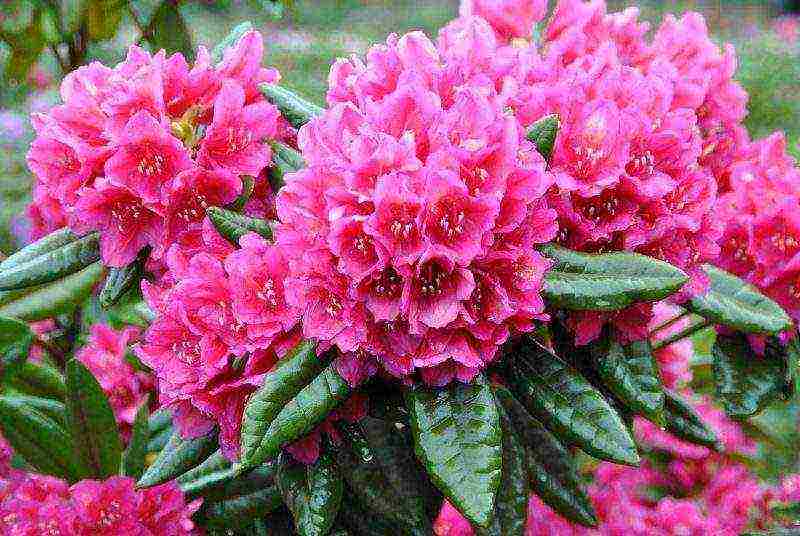
To avoid the spread of ticks, bugs, scale insects, the plant is treated with "Karbofos".
If the irrigation schedule is not followed and there is no drainage layer under the root, the plant can become infected with a fungal disease. Bordeaux liquid is used as a prophylactic agent.
Rhododendron in landscape design

To enjoy the beautiful flowers of rhododendron for a long time, you can plant the plant in groups with different flowering periods. The best place to plant would be an area near a fountain, an artificial pond. Such reservoirs can increase the humidity around the bush, and the gardener does not have to constantly spray it.
Lingonberries, blueberries, or other acidic soil lovers will be good neighbors for him.
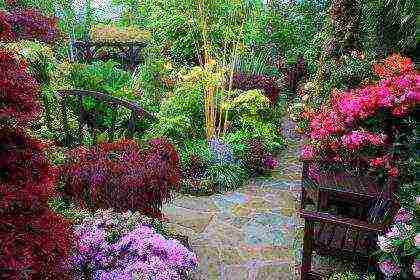
Rhododendron is for gardeners who love beauty and want to constantly care for plants. Only those whose conditions on the site fully meet the requirements of this beautiful flowering bush can not take care of the plant.
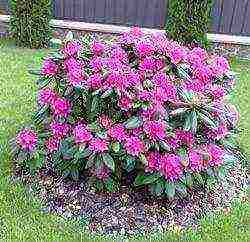 These shrubs are great during flowering. At the beginning of the 19th century, rhododendrons began to decorate the gardens of Russia for the first time. Varieties, cultivation in the open field, planting, care, reproduction: we cultivate rhododendrons according to all the rules.
These shrubs are great during flowering. At the beginning of the 19th century, rhododendrons began to decorate the gardens of Russia for the first time. Varieties, cultivation in the open field, planting, care, reproduction: we cultivate rhododendrons according to all the rules.
Description of rhododendron: varieties and varieties
The genus of rhododendrons is quite extensive - more than 1,000 species, which include various varieties of this wonderful plant. The natural area of distribution of rhododendrons is limited to the eastern countries: China, Japan, Korea, the Himalayas; some plant species are found in the Caucasus, North America, northern Africa and Australia. In European territory, two varieties of rhododendron grow in the mountainous regions of Germany.
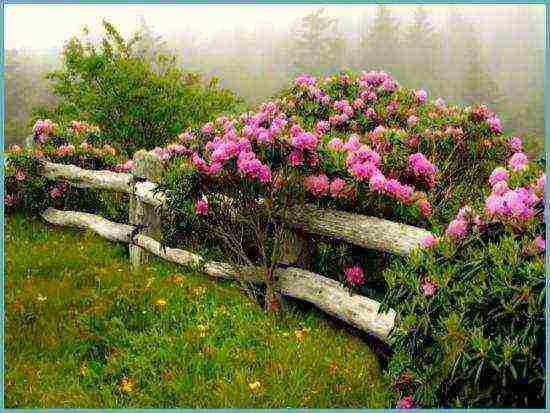
Rhododendron is a magnificent plant with a long flowering period
The culture refers to flowering deciduous or evergreen shrubs of the heather family. The branches of the plant can have smooth bark or pubescence. Leathery, dark green small ovoid leaves are sometimes pubescent. Bell-shaped flowers, funnel-shaped, simple and double. The color of the petals varies depending on the variety: white, pink, lilac, red, purple. Modern varieties of rhododendron are yellow and orange in color. Numerous small seeds ripen in capsules.
Rhododendrons, the cultivation of which on the territory of Russia is most acceptable, is limited to 26 species belonging to three groups of plants.
- Evergreens are tall shrubs that do not shed their dark leathery foliage even in winter. Large flowers are painted in different colors and tones. Growing evergreen rhododendrons in the open field requires compliance with a number of necessary rules: plants are placed in places with diffused shadow; the soil for them should include a large amount of peat.
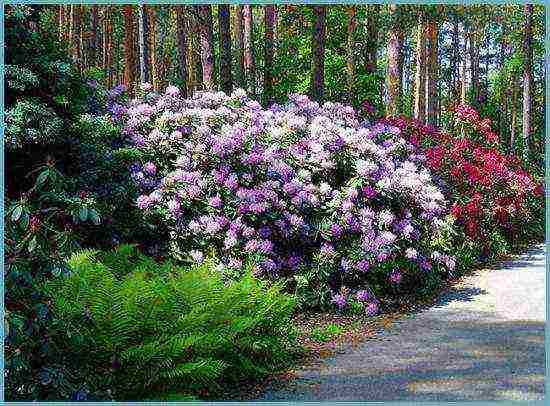
Rhododendron evergreen
Tip: It is important to choose the right neighborhood for evergreen species of rhododendron, especially when decorating territories in landscape design. It can be all types of conifers, heather, ferns grown in the open field.
- Intermediate (semi-evergreen) - low shrubs that winter well under a layer of snow.The plant is characterized by a compact form, a huge number of flowers during the flowering period. In winter, most of the leathery leaves fall off, leaving only the whorl of leaves at the ends of the branches, from the center of which new foliage grows.

Semi-evergreen rhododendron
- Deciduous - rhododendrons of this group are most adapted to the conditions of the Russian climate. The cultivation of these plants is not difficult, and the plants themselves do not need to be specially adapted in winter. Blossoming in spring, repeated in autumn.

Deciduous rhododendron, grade "Fireworks"
Planting a plant
Rhododendron: planting and caring for plants in compliance with agrotechnical rules - plant transplantation is allowed in spring and autumn. In autumn - in any of three months, in spring - in warm, well-established weather, when the soil is no longer frozen (usually April or May).
The choice of a place for planting a plant must be carried out with special care. Planting rhododendrons should be protected from the prevailing wind and direct sunlight. It is important that the shrub is accessible for viewing, then the decorative appearance of the plant during the flowering period will decorate the territory and please the eye.
Tip: Before planting the plant from the container into the open ground, it should be thoroughly saturated with water.
A planting hole for rhododendron bushes is prepared based on the actual size of the root system, and should be 2 times larger in volume. The natural soil should be removed completely. To plant a plant, it is required to prepare a special earthen soil consisting in equal parts of heather earth; peat; garden soil or leaf humus; rotted manure; needles (pine).
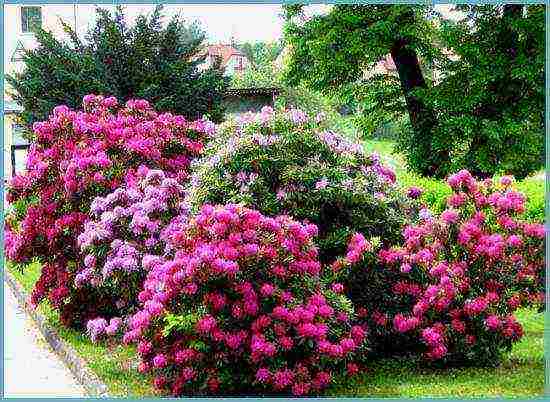
It is very important to plant the plant correctly, then it will quickly take root.
The prepared pit is filled with a mixture, a place is prepared in it for planting a rhododendron bush, which must be placed strictly vertically. The soil around the root system of the plant must be tightly squeezed - the formation of voids and "pockets" in the planting soil is not allowed. At a high level of groundwater, it is necessary to provide for the laying of a special drainage layer at the bottom of the pit. After planting, the top layer of soil should be mulched with peat chips.
Rhododendron: proper watering
Watering the planted plant is carried out at the time of planting, - abundant, sufficient to moisten the soil to a depth of 20-30 cm. Subsequent watering of rhododendron should be done with soft, acidified water, with full soil moisture.
Tip: When planting a plant with buds, it is necessary to remove most of them.
Plant care
A transplanted plant requires attention and careful care. In addition to regular abundant watering, the rhododendron needs spraying over the foliage, especially when planting in late spring. The soil needs to be mulched to maintain sufficient moisture. When mulching, you should choose options that increase the acidity of the soil.
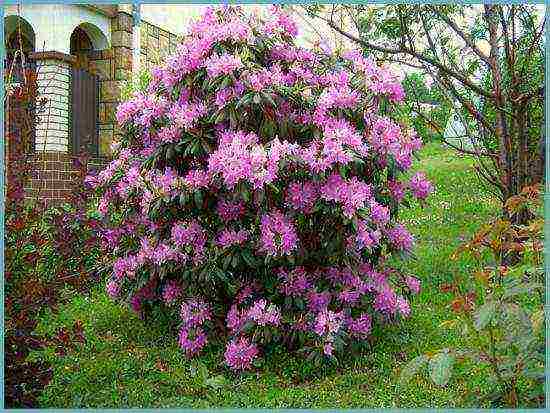
The plant needs regular watering
The root system of rhododendrons consists of delicate, fine hairs, similar to matted hair, so loosening the soil, especially deep, should be excluded from flower care measures. Weeds growing next to the plant need to be removed periodically.
The appearance of the plant will immediately inform about the lack or excess of water - the leaves of the rhododendron will begin to turn yellow and fall off. Watering is required in sufficient quantities, but without overflow, this is one of the main rules of crop care.
To ensure proper care of the rhododendron, it is important to timely prune the overgrown bushes. Places of cuts to prevent infection of the plant are covered with paint or garden varnish.
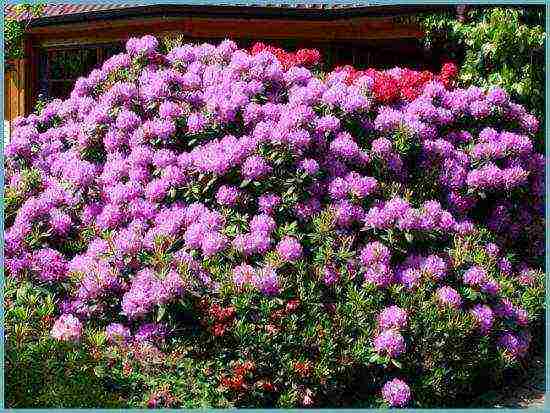
Bushes need to be pruned periodically
Compliance with simple plant care requirements will allow you to grow a wonderful flowering bush.
Fertilizing and feeding rhododendron
In the first year, the transplanted plants already require careful fertilization, which is applied in a highly diluted form, in small portions. The plant itself will signal the need for fertilization: it will stop growing, discard the foliage or the leaves change color, the formation of flower buds will stop.
Organic fertilizer for feeding rhododendron bushes - semi-decomposed manure, which must be infused in water. Top dressing is carried out with an aqueous solution of manure. To increase the formation of flower buds, as well as to extend the flowering period, granular superphosphate, or double superphosphate, is used, which is scattered over the moist soil under the plants. The plant is also useful for fertilizing with microelements - fertilizers are applied in the form of watering or spraying the green mass of the bush. Intensive fertilization of the bushes is required until the end of August.

Rhododendron before flowering
Reproduction of rhododendron
Growing rhododendron involves plant propagation by layering and seeds, dividing the bush, grafting, cuttings.
Seed propagation Is a great way to get plants with improved traits. Sowing is carried out from the end of December to the end of March. The second period suitable for seed reproduction of rhododendrons is the end of November.
Sowing seeds is carried out in shallow bowls or boxes filled with a nutrient mixture of peat, sand, coniferous and sod land, taken in equal proportions. The seeds are pre-soaked for a day. Sowing is carried out on the top layer of the soil, without embedding deep into the soil. The sowing is moistened by spraying. It is required to provide seedlings with a 12-hour illumination with fluorescent lamps. The timing of seed germination depends on the variety. The first flowering of seedlings is possible in 3-4 years.
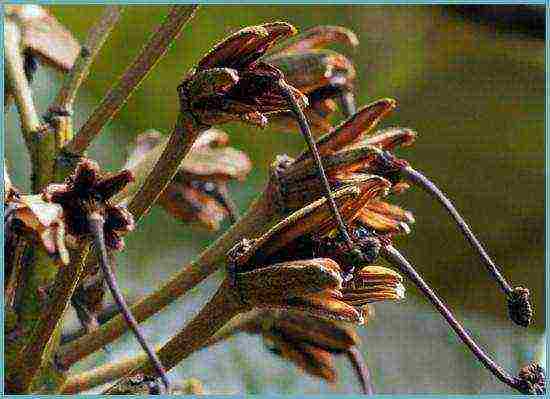
Rhododendron seeds
This method has its advantages, but with seed reproduction of rhododendrons, it takes up to 5-6 years to obtain full-fledged plants.
Faster new plants can be obtained with vegetative methods of culture propagation: cuttings, dividing the bush, rooting of cuttings.
Diseases and pests
Fulfillment of the requirements for agricultural technology of rhododendrons guarantees excellent growth and development of plants. However, repeated waterlogging or overdrying of the soil, alkaline reaction of the soil, sunburn of leaves, can provoke an outbreak of crop diseases.
Plants can be damaged by spots, rust and chlorosis. Disease control measures - improving the conditions for keeping plants, the use of special means to combat diseases. Often, rhododendron diseases are caused by pathogenic fungi: gray rot, fusarium, late blight.
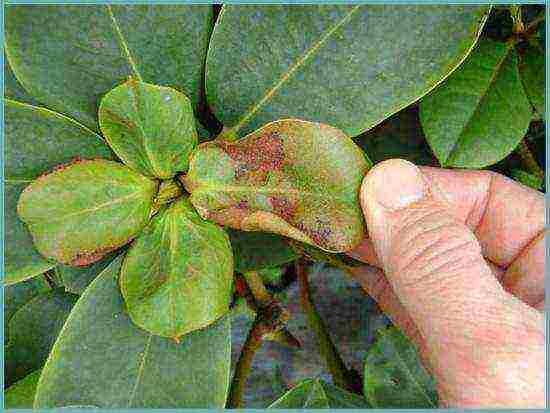
Spotting - a fungal disease of the rhododendron
Pests that damage rhododendrons: slugs and snails that eat young leaves and buds. The collection of these pests is done manually. In addition, the plant is harmed by: bedbugs (rhododendron), spider mites, mealybugs, weevils, scale insects, rhododendra fly. Pest control is easy with systemic insecticides.
Rhododendron: combination with other plants
Planting plants in combination with conifers and a group of heathers has a positive effect on the development of rhododendrons. It should be remembered about the height of the rhododendron bush. Low cultivars should be located away from the dense shade of mature trees, but avoiding direct sunlight.

Blooming rhododendron perfectly sets off conifers
An excellent combination is observed when located next to the rhododendrons of shade-loving ferns and host.
Rhododendron in landscape design
In landscape design, rhododendron is an indispensable attribute for planting in partial shade. The huge advantages of the plant are its long and very decorative flowering.Rhododendrons are widely used in the design of heather gardens, as an addition to the planting of pine groves. The plant looks great in mono plantings.

Rhododendron in landscape design
Low-growing varieties of rhododendrons are planted near alpine hills, in mixborders and in decorative flower beds.
Planting a garden rhododendron: video
Types of rhododendron: photo


